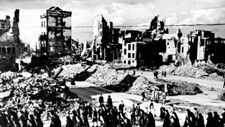
New Freedoms
Even as rubble and provisional facilities still characterised the appearance of many towns and villages, artists and those active in the media of the post-war era endeavoured to get back to work. Until the war ended in 1945, the National Socialists had controlled art, press and radio. But now the British had created a framework for free expression within the young democracy.
Theatres quickly filled up again, the people enjoying the diversion. This part of history can be found in the large display case with the theatre costumes. More and more controversial subjects began to appear on stage. A rich cultural landscape developed.
Artists continually searched for new avenues, breaking with convention at times. One example is Joseph Beuys, whose art event we show in the video beneath the window.
Today’s diverse media landscape emerged from the strong and broad foundation created by publishers, artistic directors and journalists in the post-war period. Rivalries intensified the competition. Unfortunately, they also led to journalistic taboos being broken – the media installation at the end of the exhibition details the example of the Gladbeck hostage drama.
In the early days after the Second World War, people of action with strong personalities were needed to shape the media. You will find several of these important “strong-headed individuals” right at the front of the room.